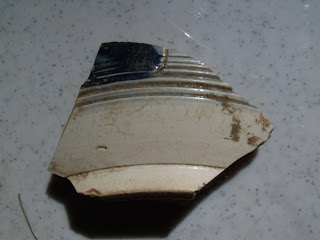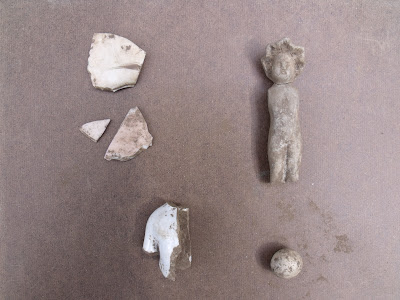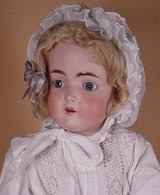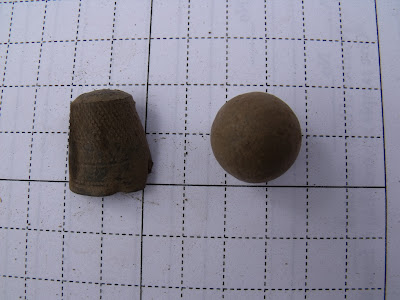We rushed to finish up our units, and finished all the excavation for the rest of this year in Bladensburg. We still have a little bit of profiling to do next week. We will also post some blogposts to sum up the preliminary site findings and showcase some of the really unusual artifacts we found this past field season. Keep in touch!
Friday, September 24, 2010
Market Master's house backlot, Day 10: "Last Day, Well Almost...."
We rushed to finish up our units, and finished all the excavation for the rest of this year in Bladensburg. We still have a little bit of profiling to do next week. We will also post some blogposts to sum up the preliminary site findings and showcase some of the really unusual artifacts we found this past field season. Keep in touch!
Thursday, September 23, 2010
Market Master's backlot, Day 9, "One Day Left!"
 This post is from Janet Donlin. Janet has worked on almost all of the sites here in Bladensburg, and has also done her share of artifact analysis and preparation for the project:
This post is from Janet Donlin. Janet has worked on almost all of the sites here in Bladensburg, and has also done her share of artifact analysis and preparation for the project:Tomorrow is our last day here at Market Master’s, and we have our work cut out for us. We have three units left to dig, two of which we opened up yesterday. Frank, Jen, and Courtney are about a foot into unit 18, and Rick, Molly, and Nicole are blasting their way through unit 17. There’s some good news for me and Mike in our unit…we’ve finally got a unit with some cool artifacts! Today we pulled out a bone button, the neck and mouth of a bottle with an applied lip, a fancy looking piece of iron that could possibly be part of a gun or door hardware, a pewter

 utensil, and a very nice piece of a bowl with a multi-chambered slip featuring horizontal tri-colored twigs and green glazed rilling. Put this all together, and it looks like we are well into the early 19th century. We’ve also recovered a lot of big chunks of bone, some of which are burnt.
utensil, and a very nice piece of a bowl with a multi-chambered slip featuring horizontal tri-colored twigs and green glazed rilling. Put this all together, and it looks like we are well into the early 19th century. We’ve also recovered a lot of big chunks of bone, some of which are burnt.Unit 17 is already into the prehistorics. The unit was opened up yesterday, and dug through pretty quickly. There was a 20th century feature in the southwest corner, and they have recovered a lot of 19th and late 18th century ceramics, but few colonial artifacts. They are finding a lot of rhyolite and some quartzite flakes, all debitage so far. It is really interesting to see which units are yielding the colonial artifacts and which are showing a strong prehistoric presence. Most of the colonial artifacts seem to be concentrated in units closest to and directly behind Market Master’s house. We have yet to find a privy, though, and it’s still a mystery to where that might be.

Unit 18 is still at a more modern level. They’ve been recovering a lot of nails, more modern ceramics and glass, and some pretty large pieces of shell edged wares. Unit 18 is right between two units that found lots of great prehistoric points and flakes, so perhaps this unit will find that as well.
We have one more day to dig and three units to finish up, but we have a lot of great archaeologists out here and we should have no problem wrapping things up. We’ve found a lot of really neat things, but I have to say my favorite is probably the little plastic dinosaur from the first day. It’s just so cute!

Wednesday, September 22, 2010
Market Master's house backlot, Day 8: "Julie's Assesment"
 Other updates include the conclusion of one of the most disturbed units on the site. To the far south, we discovered numerous 20th century intrusions and metal pipes. (see picture, left) It is amazing that only 15 feet to the north there is a beautifully stratified prehistoric site with colonial artifacts sprinkled on top. The last decision of the day is whether or not to open another unit….it only gives us two days to excavate, but we can spill over to next week to finish this last unit. The new unit will connect the prehistoric tool production area and the area with beautiful colonial artifacts such as
Other updates include the conclusion of one of the most disturbed units on the site. To the far south, we discovered numerous 20th century intrusions and metal pipes. (see picture, left) It is amazing that only 15 feet to the north there is a beautifully stratified prehistoric site with colonial artifacts sprinkled on top. The last decision of the day is whether or not to open another unit….it only gives us two days to excavate, but we can spill over to next week to finish this last unit. The new unit will connect the prehistoric tool production area and the area with beautiful colonial artifacts such as  featheredge creamware, debased scratch blue stoneware, (picture, left) and a French gun flint.
featheredge creamware, debased scratch blue stoneware, (picture, left) and a French gun flint. Tuesday, September 21, 2010
Market Master's house backlot, Day 7: "Unit 15 Update"
Today we have an update from University of Maryland student Jen Allen who spent the day working on Unit 15 where they have been point proveniencing all the flakes coming out of the unit. This means they mapped in the location, including depth of each piece of prehistoric stone tool-making waste for later analysis. Jen had this to say:
"It’s been an exciting day today at the Market Master’s House. I have been helping Frank excavate TU 15, the unit directly west of TU 12, which yielded so many rhyolite flakes last week. TU 15 has not disappointed as the concentration of rhyolite flakes clearly continues. In one level alone 100 rhyolite flakes were recovered along with 2 sherds of Native American ceramics and a large quartzite cutting or chopping tool. (see picture below, left) The plan for the next level was to take a pollen sample and after only a few trowel cuts into the soil what we think could be an archaic bifurcate quartz point was found. (picture below, right) I’m looking forward to see what else this unit has to offer and how far back in Bladensburg’s past we’ll go."
Monday, September 20, 2010
Market Master's house backlot, Day Six: "Looking Back at Five Excavations in Bladensburg"

In the last two years I have taken part in five excavations in
 Bladensburg. Each site has been distinctly different, with its own revelations, quirks and mysteries. Speaking from an excavation conditions standpoint, we all agree that this site has been a pleasure to dig. The pleasant weather, the sandy smooth soils, the shady backyard and the accommodating land owners have all contributed to this. This time we have employed a strategy of grouping our units closely this time, in order to open a larger space clustered in the back of the Market Master’s house. This has allowed us to discuss our findings and compare our soils as we dig. It has really helped us to create a more cohesive picture of the historic landscape of this area. That doesn’t mean there aren’t many mysteries to solve….
Bladensburg. Each site has been distinctly different, with its own revelations, quirks and mysteries. Speaking from an excavation conditions standpoint, we all agree that this site has been a pleasure to dig. The pleasant weather, the sandy smooth soils, the shady backyard and the accommodating land owners have all contributed to this. This time we have employed a strategy of grouping our units closely this time, in order to open a larger space clustered in the back of the Market Master’s house. This has allowed us to discuss our findings and compare our soils as we dig. It has really helped us to create a more cohesive picture of the historic landscape of this area. That doesn’t mean there aren’t many mysteries to solve….Retrospectively, however, there are a few things from this site that have been consistent with many of the sites we have excavated here in Bladensburg.
 -The material culture of conflict in the form of Civil War or War of 1812 bullets, uniform buttons and gunflints. As yet we have not tabulated how many of these we have collected throughout Bladensburg or what they can tell us about the town during these conflicts, but future research may reveal new facts. This site has been no exception, with a musketball, gunflints and military buttons.
-The material culture of conflict in the form of Civil War or War of 1812 bullets, uniform buttons and gunflints. As yet we have not tabulated how many of these we have collected throughout Bladensburg or what they can tell us about the town during these conflicts, but future research may reveal new facts. This site has been no exception, with a musketball, gunflints and military buttons. -Evidence of prehistoric lives have been found at almost all the sites we have excavated in Bladensburg suggesting long and extensive Native American occupation in this location dating back as early as six thousand years ago. As discussed in previous blogposts, the ecological richness of this area, at the junction of two streams with a rich floodplain and numerous natural springs, would have made the Bladensburg area very attractive to prehistoric inhabitants.
-Evidence of prehistoric lives have been found at almost all the sites we have excavated in Bladensburg suggesting long and extensive Native American occupation in this location dating back as early as six thousand years ago. As discussed in previous blogposts, the ecological richness of this area, at the junction of two streams with a rich floodplain and numerous natural springs, would have made the Bladensburg area very attractive to prehistoric inhabitants. -Late-nineteenth and twentieth century efforts to modernize or otherwise modify old features to meet modern needs. In this section we could include the extensive efforts by the early twentieth century occupants of the Bostwick house to modernize and fashionably remodel the architecture and landscape around the house. This included removing older structures such as outbuildings and, probably, slave and servant’s quarters. At the Magruder house and Indian Queen Tavern we saw drainage systems put in an effort to keep the Anacostia floodwaters at bay. At the Indian Queen we saw a historic well reconstructed as a system for draining the house. Here in the backyard of the Market Master’s House we have seen some evidence of twentieth century construction, including the possibility of a similar effort. (more on this in a future blogpost?)
One question we can begin to ask now is: “What have we not seen in Bladensburg that we might have expected?”. We have not seen much evidence of what we know was probably a big business in Bladensburg, the trade in enslaved peoples from Africa. Neither have we seen much evidence of the lives of those that lived in Bladensburg in forced servitude. Additionally, we do not have a good sense of how the laboring classes in Bladensburg might have lived. Though four brick or stone eighteenth century structures have survived Bladensburg’s 250+ year history, we know that the majority of structures in Bladensburg were modest wood frame dwellings. Who lived in these houses and how did there lives differ from the lives of those that lived in the wealthier portions of the town? Archaeology and additional research and analysis conducted in the future may have the answers to some of these questions...
Friday, September 17, 2010
Market Master's House, Day Five. Porcelain Doll Parts!
 The cluster of peach colored pieces in the upper left of the picture represents two different unglazed bisque porcelain heads. One piece shows a portion of a large eyebrow and eyelashes. Given the size of the painted eyebrow, the doll head must have been quite large, like the example pictured below. Bisque porcelain dolls were introduced in the 1860s.
The cluster of peach colored pieces in the upper left of the picture represents two different unglazed bisque porcelain heads. One piece shows a portion of a large eyebrow and eyelashes. Given the size of the painted eyebrow, the doll head must have been quite large, like the example pictured below. Bisque porcelain dolls were introduced in the 1860s.
The doll on the nearly complete doll on the right is also an unglazed bisque doll. The body was found in the first level of TU 14 and the head found in the following level. This doll is known as a “penny doll”, “Frozen Charlotte”, or “bathing dolls”. These were produced from the late 1800s to about 1930. The body is all bisque whereas the doll described above would have had a fabric torso with porcelain limbs. Below is another example of a bathing doll.
 The last doll has me a bit stumped. The porcelain is glazed, unlike the other dolls. The attached arms, size, and porcelain torso makes it look like a penny doll, but it shouldn’t be glazed. Early “China dolls” with white glazed heads had fabric bodies so our example doesn’t fit. What these dolls do tell us is that children played in this area during the 19th and early 20th century. These children may not have had a big impact on the history of the site, but these few doll pieces are clues to their presence amongst the nails, animal bone, and bottle glass.
The last doll has me a bit stumped. The porcelain is glazed, unlike the other dolls. The attached arms, size, and porcelain torso makes it look like a penny doll, but it shouldn’t be glazed. Early “China dolls” with white glazed heads had fabric bodies so our example doesn’t fit. What these dolls do tell us is that children played in this area during the 19th and early 20th century. These children may not have had a big impact on the history of the site, but these few doll pieces are clues to their presence amongst the nails, animal bone, and bottle glass.Thursday, September 16, 2010
Market Master's House, Season Two, Day Four, A Day of Transitions
 Quiet around here after the excitement of yesterday. A brief post from Molly Russell today:
Quiet around here after the excitement of yesterday. A brief post from Molly Russell today: Hi from the Market Master’s House! It has been a fairly slow day here – well, at least it has for one unit. Unit 9, the one I have been gracing with my presence, has featured a whole lot of digging and not much artifact-ing. We’ll be finishing it up today and opening up a new unit next to it, so hopefully tomorrow will be a more interesting day. Units 10 and 12, however, have been finding a ton of prehistoric flakes. Mike and Janet pulled a really nice point out of unit 10 this morning, while Jen and Frank have had bag after bag of flakes come out of their unit. It has been said that this is becoming more of a prehistoric site rather than a historic one, and I am starting to agree!
After closing out their unit (10) just before lunch, Mike and Janet opened up a new one (14). So far they have found a mixture of artifacts from different centuries, which makes us wonder how intact the historic material will be in that unit. That question will most likely have to wait until tomorrow. So, I guess you could say this site is a ‘to be continued…’
Top photo, by Janet Donlin, of a caterpillar on a screen. Below, Top: Courtney Singleton digging out the bottom of Unit 9. Middle: Nichole Sorenson-Mutchie profiling the wall of the same unit. Bottom: View of the site from the east.



Wednesday, September 15, 2010
Market Master's House, Second Season, Day 3, What a Surprise Today!
 Everyone came in feeling a bit tired for our third day of fieldwork. We have had an interesting few days, but are already coming towards the bottoms of our first units. Luckily, we found some pretty neat stuff! Another piece of the puzzle we are putting together about Bladensburg's history. We asked Frank Mikolic and Zak Andrews to talk about what they were finding in Test Unit 12, located in the central portion of the site. Here is what Zak had to say:
Everyone came in feeling a bit tired for our third day of fieldwork. We have had an interesting few days, but are already coming towards the bottoms of our first units. Luckily, we found some pretty neat stuff! Another piece of the puzzle we are putting together about Bladensburg's history. We asked Frank Mikolic and Zak Andrews to talk about what they were finding in Test Unit 12, located in the central portion of the site. Here is what Zak had to say:  The two points were accompanied by a few dozen stone flakes, none much larger than the size of my pinky fingernail. Prehistoric/archaic artifacts were the last thing I was expecting to find among the colonial theme of things, so naturally I am thinking, “What does this all mean!?” With the help of my Maryland colleagues and the fine staff at the SHA, I’m sure we can come to the bottom of this mystery. This was my first discovery of a worked stone since my emerging practice into the field of historic archaeology and has surely caught my interest. Just goes to show you that you can never be too sure of what you might find out in the field; the past might just surprise you."
The two points were accompanied by a few dozen stone flakes, none much larger than the size of my pinky fingernail. Prehistoric/archaic artifacts were the last thing I was expecting to find among the colonial theme of things, so naturally I am thinking, “What does this all mean!?” With the help of my Maryland colleagues and the fine staff at the SHA, I’m sure we can come to the bottom of this mystery. This was my first discovery of a worked stone since my emerging practice into the field of historic archaeology and has surely caught my interest. Just goes to show you that you can never be too sure of what you might find out in the field; the past might just surprise you."

Tuesday, September 14, 2010
Market Master's House, Season Two, Day Two
 This message was written by Rick Ervin from the Maryland State Highway Administration:
This message was written by Rick Ervin from the Maryland State Highway Administration: We started a test unit at the back of the Market Masters property on Monday. So far, we’ve had a mix of everything between about 1800 and late 2008. Late this morning we started excavating a feature – the boundary appeared somewhat amorphous, but it was obviously different from the surrounding matrix. As it turned out, we had a trench for a water pipe. Although I had hoped it might have turned out to be a little earlier, we are starting to find some earlier ceramics, including edgeware and various transfer print sherds.

We also found a small cross, about which Courtney may have more to say in the near future. We’ve heard that the cinder block garage situated within 20 feet of our unit was once part of a small service station or auto repair shop. We’ve found a few artifacts that appear to be tool parts and may relate to the garage.
Earlier today, another unit produced a lead musket ball that probably relates to the Battle of Bladensburg. A quick measurement indicates that the diameter of the ball is slightly more than one-half inch, suggesting that it may represent an American round that was fired into the British positions within the town of Bladensburg. Most of the American militia units were armed with .58 caliber muskets that fired a ball with a slightly small diameter (about .52 caliber). See a picture of the musket ball below, along with a thimble found in the same stratum, possibly dating to around the same time:
 Earlier, the family that lives here stopped by to see the site. Unfortunately, we had not found much at the time they stopped by. Hopefully they will come back soon so we can show them the good stuff – we appreciate their hospitality!
Earlier, the family that lives here stopped by to see the site. Unfortunately, we had not found much at the time they stopped by. Hopefully they will come back soon so we can show them the good stuff – we appreciate their hospitality!The weather of course has been perfect now that the heat of summer is dissipating. Despite the traffic noise, we have quite an idyllic setting here under the trees. However, we just heard the call to start packing up for the day, so its time to sign off for now.....
Monday, September 13, 2010
After excavating almost 20 shovel test pits, we opened up three five foot by five foot units and just made it through the first stratum. After finding a plastic dinosaur, we soon came down upon 19th and some colonial artifacts. There is nothing too out of the ordinary yet, but we hope to connect the post molds from last year to see if we can recognize a structure.
After our excavation last year, we hit the old records to learn what the Market Master’s house was really used for and who lived here. What we learned is that there is no documentation for the building being lived in by a “market master”. Instead, the building appears to have been Christopher Lowndes’ store and one of the first mail stops in the country. It is possible people lived above the store, but based on the probate inventory the store was packed with a long list of items that would have made for camped quarters. By the late 1850s, Dr. Anderson bought the lot with Lowndes’ old store and he lived with his wife in a separate residence to the southeast on the same lot. We are not sure if the old store was used as a doctor’s office or rented out. The 1860 slave census does show Thomas Anderson owning a 51 year old female and 12 year old male slave. Did they use the Market Master’s House as a slave quarter? We may never know for sure, but is something to keep in mind as we examine the mid 19th century artifact assemblage.
